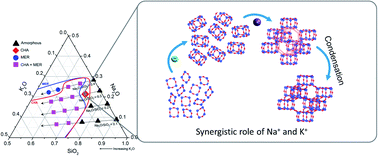Revisiting the seed-assisted synthesis of zeolites without organic structure-directing agents: insights from the CHA case†
Abstract
Herein, the crystallization behaviour of the CHA zeolite synthesized via the seed-assisted method and in the absence of an organic structure-directing agent has been revisited. To date, the working hypothesis of the seed-assisted synthesis method is that the parent gel and seed share the common composite building unit (cbu) of the targeted zeolite crystal. In the case of the CHA zeolite, we reveal that the parent gel in the absence of CHA seeds leads to the formation of the MER zeolite, which does not follow the cbu working hypothesis. It appears that smaller, but essential common units, i.e., 4-membered ring (4-MR) aluminosilicate, play a key role, instead of a larger cbu. The parent gel contains 4-MRs, which can grow into MER and/or CHA, depending on several factors, i.e. alkalinity, Si/Al ratio, synergistic effects of Na+ and K+, and the seeds. In this study, the CHA zeolite with an Si/Al ratio of up to 15 was selectively crystallized in the presence of CHA seeds at suitable alkalinity ((Na2O + K2O)/SiO2 < 0.4) with a fixed point at the tie line of Na2O/SiO2 = 0.3 with K2O/SiO2 = 0.1. Subsequently, the ternary phase diagram was drawn as high alkalinity with (Na2O + K2O)/H2O > 0.4 showing the formation of an MER zeolite, a thermodynamically more stable phase than the CHA zeolite, whereas low alkalinity with (Na2O + K2O)/SiO2 < 0.4 showed the less crystalline CHA zeolite or amorphous products with MER as a competing phase. The crystallization of the CHA zeolite was found to be strongly dependent on the synergistic effects of sodium and potassium ions. The former appears to organize the 4-MRs into essential double-six rings (d6rs), while the latter arranges the formed d6rs into cha cages. The seeds are partially dissolved and provide the outer surface for the crystal growth of CHA. We anticipate that these results may provide useful insight for understanding the crystallization of zeolites and stimulate versatile design in the synthesis of zeolites, particularly for the industrially demanding seed-assisted technique.



 Please wait while we load your content...
Please wait while we load your content...